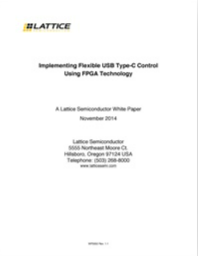Implementing Flexible USB Type-C Control Using FPGA Technology
Type-C interfaces bring dramatic benefits to consumers. However, in order to realize this potential designers must implement Type-C's Power Delivery (PD) protocol, detect cable orientation and switch high speed signals, as needed and, if desired, provide support for Vendor Defined Messaging (VDM).
This whitepaper will show you how low-cost FPGA devices can be used in combination with off-the-shelf USB devices to develop products which take full advantage of the interface's speed, power and versatility, and how they can be brought to market in a rapid manner.
Download this whitepaper to find out more.
Read More
By submitting this form you agree to Lattice Semiconductor Corporation contacting you with marketing-related emails or by telephone. You may unsubscribe at any time. Lattice Semiconductor Corporation web sites and communications are subject to their Privacy Notice.
By requesting this resource you agree to our terms of use. All data is protected by our Privacy Notice. If you have any further questions please email dataprotection@techpublishhub.com
Related Categories: Analog, Communication, Embedded, Power, Processors, Resistors, Switches

More resources from Lattice Semiconductor Corporation
Reducing Cost and Power in Consumer Applications Using PLDs
The need to respond to changing market standards in a compressed time to market window has led to the widespread use of programmable logic devices ...
An FPGA Approach to Implementing Time-Critical Functions in Multi-Sensor Mobile Designs
Today's massive smartphone market is often depicted as a hotbed of innovation for the continual advancement of cost-effective, power efficient solu...
Implementing Flexible USB Type-C Control Using FPGA Technology
Type-C interfaces bring dramatic benefits to consumers. However, in order to realize this potential designers must implement Type-C's Power Deliver...
